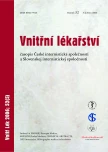-
Medical journals
- Career
Diffuse idiopathic skeletal hyperostosis and its relation to metabolic parameters
Authors: A. Pavelková; K. Pavelka
Authors‘ workplace: Revmatologický ústav, Praha, ředitel prof. MUDr. Karel Pavelka, DrSc.
Published in: Vnitř Lék 2006; 52(5): 477-480
Category: Diabetes and other subjects (infection, dermatovenerology and rheumatology) Hradec Králové 3 to 4 June 2005
Overview
Diffuse idiopathic skeletal hyperostosis (DISH) is a non-inflammatory disease of skeleton characterized by hyperostosis of axial and peripheral skeleton. The association of DISH with type 2 diabetes mellitus and other metabolic alterations (e.g. impaired lipid metabolism) has been known for many years. However, it has not been explained satisfactorily yet. It seems that this pathological process is significantly influenced by hyperglycemia and insulin resistance. Also, it is affected by growth hormone (GH) and its action mediated by insulin-like growth factor (IGF) and its binding proteins (IGFBP2, IGFBP3). From the point of symptomatic therapy, patients should not be given medicaments that aggravate hyperinsulinemia.
Key words:
DISH – hyperostosis – diabetes mellitus – insulin resistance – IGF
Sources
1. Smythe H, Littlejohn G. Diffuse idiopathic skeletal Hyperostosis. In: Klippel JH, Dieppe PQ. Rheumatology. St Louis: Mosby 1994; 9 : 1-9.
2. Littlejohn GO, Urowitz MB. Peripheral enthesopathy in difuse idiopathic skeletal hyperostosis (DISH): a radiological study. J Rheumatol 1982; 9 : 568-572.
3. Resnick D, Saul SR, Robins JM. Difuse idiopathic skeletal hyperostosis (DISH): Forestier´s disease with extra spinal manifestations. Radiology 1975; 115 : 513-524.
4. Jalkunen H, Heinonen OP, Knekt P et al. The epidemiology of hyperostosis of the spine together with its symptoms and related mortality in general population. Scand J Rheumatol 1973; 40 : 581-591.
5. Fortin PR, Mata S, Joseph L et al. Is difuse idiopathic skeletal hyperostosis a distinct entity? A controlled study. Arthritis Rheum 1995, 38(Suppl): 657 (abstract).
6. Kamila M, Farada A, Mizuno M et al. Association between a polymorphism of the transforming factor-beta 1 gene susceptibility to ossification of the posterior longitudinal ligament in Japanese patients. Spine 2001; 26 : 1264-1266.
7. Littlejohn GO. Insulin and new bone formation in difuse idiopathic skeletal hyperostosis. Clin Rheumatol 1985; 4 : 294-300.
8. Littlejohn G. DISH. In: Hochburg et al. Rheumatology. St Louis: Mosby 2003; 1863
9. Littlejohn GO, Smythe HA Marked Hyperinsulinemia after Glucose Challenge in Patients with Diffuse Idiopathic Skeletal Hyperostosis. J Rheumatol 1981; 8 : 965-968.
10. Bluestone R, Bywaters EG, Hartoo M et al. Acromegalic arthropathy. Ann Rheum Dis 1971; 30 : 243-250.
11. Bošák V, Žlnay D, Navrátil J et al. Imunogenetické aspekty při ankylozujúcej hyperostóze. Rheumatologia 1988, 24 : 8-14.
12. Brixen K, Nielsen HK, Mosekilde L et al. A short course of rhGH stimulates osteoblasts and activates bone remodeling in normal human volunteers. J Bone Miner Res 1990 : 5: 609-618.
13. Russel RGG, Bunning RAD, Hughes DE et al. Humoral and local factors affecting bone formation and resorption. In: Stevenson JC (ed). New techniques in Metabolic Bone Disease. London: Wright 1990 : 1-20.
14. Oursler MJ, Osdoby P, Pyfferoen J et al. Avian osteoclasts as estrogen target cells. Proc Natl Acad Sci USA 1991; 88 : 6613-6617.
15. Canalis E. Growth factors and their potential clinical value. J Clin Endocrinol Metab 1992; 75 : 1-4.
16. Lian JB, Stein GS, Canalis E et al. Bone formation: osteoblast lineage cells, growth factors, matrix proteins, and mineralization process. In: Favus MJ (ed). Primer on the metabolic bone diseases and disorders of mineral metabolism. 4th ed. Philadelphia: Lippincott Williams and Wilkins, 1999 : 14-29.
17. Baxter RC, Martin JL Radioimmunoassay of growth hormone-dependent insulinelike growth factor binding protein in human in human plasma. Journal of Clinical Investigation 1986; 78, 1504-1512.
18. Frystyk J, Skjaerbaek C, Dinesen B et al. Free insulin-like growth factors (IGF I and IGF II) in human serum. FEBS letters 1994; 348 : 185-191.
19. Khosla S, Kleerekepper M Biochemical markers of bone turnover. In: Favus MJ (ed) Primer on the metabolic bone diseases and disorders of mineral metabolism. 4th ed. Philadelphia: Lippincott Williams and Wilkins, 1999 : 128-134.
20. Pavelková A, Havelka S, Veselá M et al. Metabolické kostní ukazatele u difuzní idiopatické skeletální hyperostózy. Rheumatologia 2001; 15 : 161-166.
Labels
Diabetology Endocrinology Internal medicine
Article was published inInternal Medicine

2006 Issue 5-
All articles in this issue
- The Nosocomial Infections and Diabetes
- Diabetes mellitus and immunization
- A role of diabetologist in management of infections in diabtics
- Pathogenesis of the connective tissue in diabetes
- Metabolic PPAR receptors and skin
- Diabetic skin changes from the dermatological point of view
- Healing of skin lesions in diabetic foot syndrome during hospitalization
- Infections and diabetic foot syndrome in field practice
- Sodium Hyaluronate and an Iodine Complex - Hyiodine® - New Method of Diabetic Defects Treatment
- Urinary tract infection in patients with diabetes mellitus
- Respiratory infections and inhalation insulin therapy
- Effects of insulin on glucose metabolism in sepsis
- Internist's view on skin manifestations of hyperlipidemia in diabetic patients
- Mycoses and diabetes
- Skin complications of diabetes mellitus therapy
- Diffuse idiopathic skeletal hyperostosis and its relation to metabolic parameters
- Rheumatologic manifestations in diabetes
- Metabolic bone diseases and diabetes
- Gout and diabetes
- Glucocorticoids and diabetes mellitus
- Anagrelide in the treatment of essential thrombocythemia (ET) and other myeloproliferative disorders with thrombocythemia based on data from patient register in the CR
- Internal Medicine
- Journal archive
- Current issue
- Online only
- About the journal
Most read in this issue- Diabetic skin changes from the dermatological point of view
- Glucocorticoids and diabetes mellitus
- Diffuse idiopathic skeletal hyperostosis and its relation to metabolic parameters
- Skin complications of diabetes mellitus therapy
Login#ADS_BOTTOM_SCRIPTS#Forgotten passwordEnter the email address that you registered with. We will send you instructions on how to set a new password.
- Career

